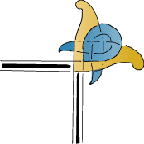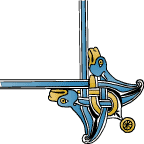STAINED GLASS WINDOWS IN ST MARY'S
click on a letter to find a photo and a description of the window
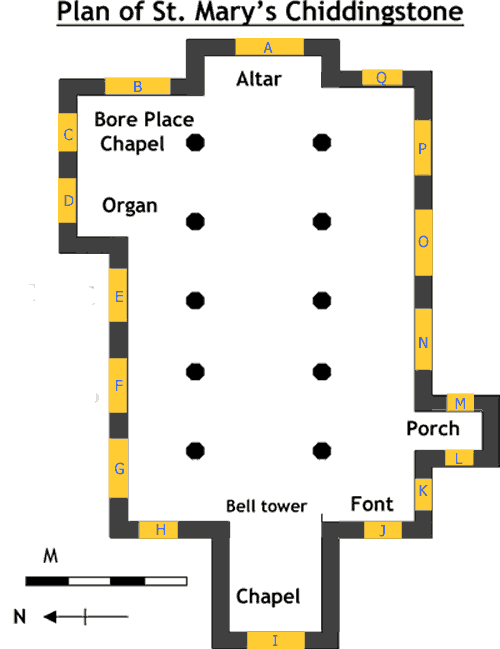
A. This window was made by the Kempe Studios in London in 1898 by John William Lisle. A wheatsheaf is painted on a quarry at the top.
Present early 14th c. stonework of the windows probably replaced earlier 13th c. triple lancets during re-building. A watercolour of 1792 shows the window, behind the high altar, full of armorial glass. On the marriage of Henry Streatfeild and Anne Sidney in 1752, a very fine collection of armorial glass was brought from Penshurst and placed in the E. window at Chiddingstone. When another Henry Streatfeild died, in 1852, the glass was returned to Lord de Lisle and Dudley at Penshurst. It remained in the house until after the 1939-45 war. It was then placed in the W. window of Penshurst Church, though during the interim most of it was lost or destroyed.
This window is dedicated to the
Glory of God and to the memory of Marion Henrietta wife of Henry Dorrien Streatfeild of Chiddingstone by those loving and beloved who are left to mourne her loss. A D 1898
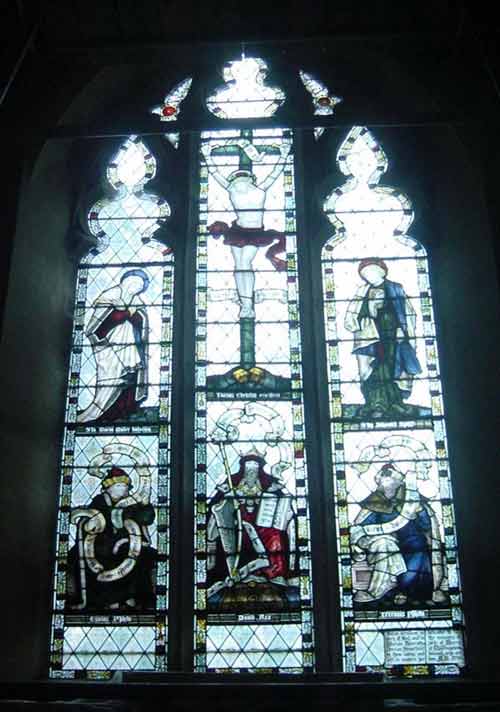
B A window of five lights, each cinquefoil-headed. The first, second and fifth are filled with clear glass, while three and four depict the Last Supper, in part.
The third light has a beaded border of pale blue with an orange five-petalled flower-head at intervals. At the head of the light a white urn containing lilies, five-headed orange flowers on each side of the urn, on a blue ground. Below this is an architectural canopy of two red roundels, containing white-flowers, within light blue panels, above two trefoil arches supported on three red
pillars with corinthian capitals on a dark blue ground containing scrolling vines. Christ, bearded, his right hand raised in blessing, has a red nimbus with orange rays and a white beaded edge. In His left hand he holds some bread. Wearing a white and gold patterned robe and red cloak, Christ sits behind the table which is covered by a white cloth with yellow and black chevron border. On the table in front of Him is a cup, a chalice and a dish of bread. St.John, in an olive robe, his left hand resting on the table, leans towards Christ. St. John's
nimbus is blue. On the opposite side of the table Judas
Iscariot is sitting, his left hand above John's foot.
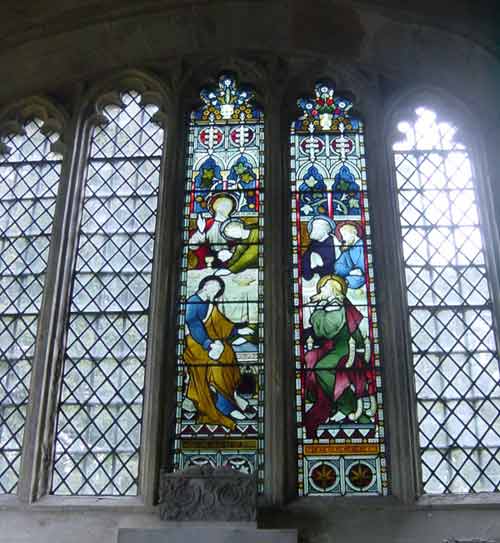
C. The royal arms from the 17th century is the oldest piece of glass remaining in the church after all the other armorial glass was returned to Penshurst in 1852. Tradition has it that rebuilding of the church in the early part of 14th c was largely at the expense of Sir Bartholomew Burgherst and that stained glass windows glowed with his coat of arms. If it was so. nothing now remains. The stonework is late Perpendicular contemporary with the chapel and the window consists of three lights and two tracery lights. The tracery lights have triangular blue glass between the main lights. The second light has, in the centre, the royal arms of Charles 1.
The royal crest is encircled with the garter and surmounted by the crown of Charles 1. The first and fourth blazons are quartered to show the fleur de lis of France and the three lions of England. The second blazon shows the loin rampant of Scotland and the third blazon the Harp of Ireland
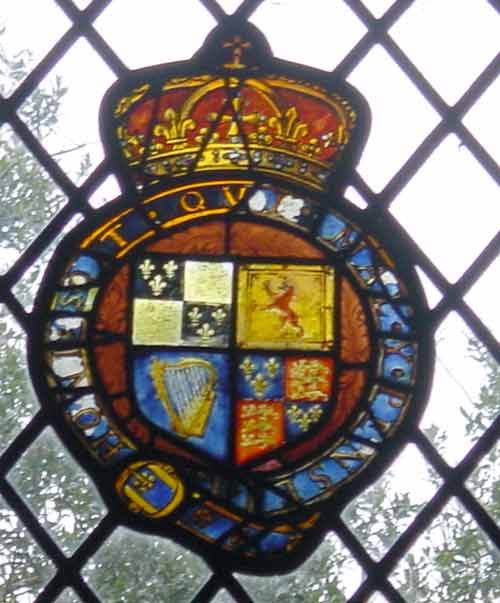
D. Window of three main lights and two tracery lights . Clear glass
E. Window of three main lights and two tracery lights. All clear glass.
F. In 17th century stonework there are three cinquefoil headed lights under a depressed arch. Each light is in two parts with a main figure above and a group scene below. The first light shows Archangel Gabriel above and a group of angels below. The second shows St. George and the dragon above, and a nativity scene below. The third shows Archangel Raphael above and a group of angels below.
This last group contains three angels looking towards the nativity scene in the central light. The angels each have a white nimbus and yellow wings like peacock feathers. The central angel has a white robe with some small black geometric motifs, and a white and yellow cloak lined in red and clasped at the neck. He is swinging a censer.
The window was commissioned by William and Edith Milburn, made by John Lisle of the Kempe Studios and completed on December 22nd. 1916. The inscription reads :
To the Glory of God and in loving memory of Richard Gerald Milburn
2 Lieut: East Surrey Regiment, and youngest son of William and
Edith Milburn aged 21 years, who was killed in action at Ypres
10th February 1915, this window is dedicated
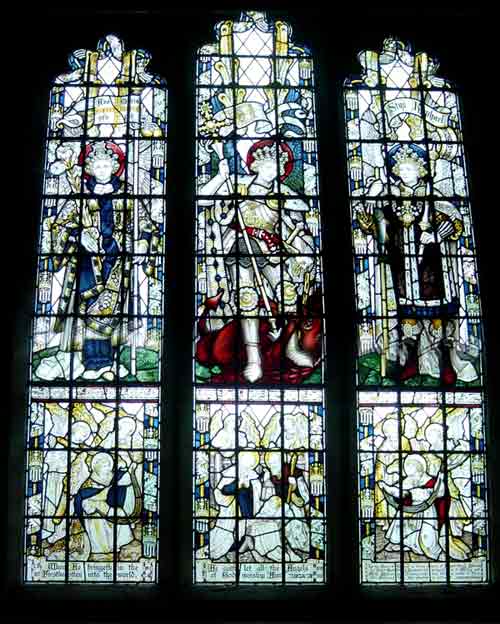
G.Plain glass
H.Stained and painted glass manufactured by Jesse Rust in 1890. According to the Churchwardens accounts from 1791 after the fire of 1624 which destroyed the original window new iron bars were fitted in 1627 costing £1
To the glory of God and in Memory
Of my dear husband William Yates Esq
Who died June 19 1888 also of his
Beloved wife Mary Cowland Yates
This window was erected in love by
His widow Henrietta Yates daughter of
Peter Aubertin rector of Chipstead
In the county of surrey RIP
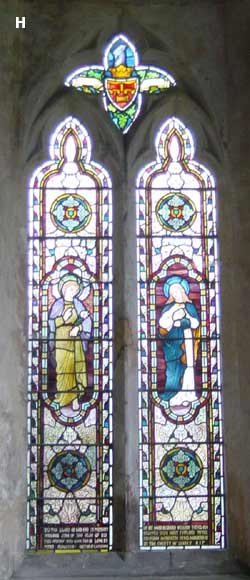
I. Window of three lancet lights and six tracery lights set in a pointed arch in 15th century stonework, which was fully restored in 1898. The tracery lights are filled with a white and yellow scrolling vine on a scarlet background. The three main lights show Christ in Majesty and the four evangelists (two on either side)against a scarlet background.
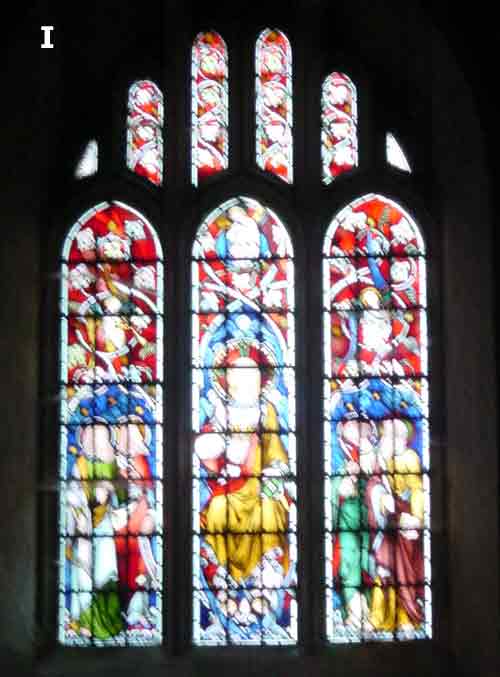
J (some sub-divided) giving a pearlised effect. Across the foot of the light, painted in brown uncials in variety and arabic numerals, on a greenish yellow ground, to be read across both lights (2) and (3), a memorial inscription. (3) The Virgin Mary standing, holding to her left shoulder the baby Jesus, facing outward. Mary wears a crown and nimbus, a long grey gown to the floor under a shorter pink and grey goldfringed tunic, showing purple at the neck. Her dark blue cloak is lined with white. The baby Jesus has a red patee-adorned white nimbus and a short white gown. His right hand is raised in blessing. The floor and background as in (2). The head of the light contains centrally a white multi-pointed star with trailing light (symbolic of the Eastern Star) and bars of green matching (2). The memorial inscription at the foot.
2. Stained and painted leaded glass.
3. 1929 4. h.200cm x w.94cm 5-6. Veronica Whall (of Ravenscourt Park, Hammersmith, London) Ref.a)
,-8~ 6ee 9.
9. THIS WINDOW IS DEDICATED TO THE GLORY OF GOD & IN LOVING REMEMBRANCE OF HARRIET LOUISA BIRT/WIFE OF ALFRED WILLIAM BIRT OF CHESHUNT HERTS by her CHILDREN AND GRANDCHILDREN A D 1929 10. Ref. a) Cormack
K. Plain glass
L.Plain Glass
M. Plain Glass
N (3) An angel with halo and folded wings, head inclined towards the central figure in (2), a sheaf of lilies within his left arm. He wears a white alb beneath a crimson tunic with gold border, a long royal-blue cloak with black embroidered orphreys. Around his shoulders and hanging centrally is a gold pallium with black embroidery. He is barefoot and stands on green foliation.(6)The panel below has an assymetric canopy of vines and the coat of arms of Eton College within a wreath of oakleaves and acorns. A band across the foot of the window, painted in black gothic caps and 1/c reads: I have kept the faith. This is followed by the insignia of the Grenadier Guards in yellow stain outlined in black paint.
Each light has a border of dark blue overlaid with silver vine leaves and gold grapes. In the head of each light the central foil in (1) and (3) contains a golden vine leaf and in (2) a golden crown. The lower foils all contain tudor roses in silver and gold. A BRASS PLAQUE is placed centrally on the sloping sill below the window (h.36cm x w.92cm). The insignia of the Grenadier Guards to the left of the inscription which is in roman caps and 1/c and arabic numerals. To the Glory of God and in m,ost beloved memory of/ GEOFFREY GEORGE GUNNIS, M.C./ Capt. in the 3 Batt. of His Majesty's first or Grenadier Regiment of Foot Guards/ who gave his life for his Country in the Great European War/ Eldest son of FRANCIS GEORGE GUNNIS & IVY his wife, & grandson of HENRY DORRIEN STREATFEILD of Chiddingstone/ Wounded Sept 15t~h 1916 during-the advance by the Guards on Les Boeufs in the battle of the Somme and died in/ hospital at Rouen Oct.13t~h aged 20. Buried with full military honours in the cemetery of S. Sever, Rouen./ He was awarded the Military Cross/ "For conspicuous gallantry initiative and ability at Big Willie on Oct. 8 1915. He led his men with great dash/ attacked the Germans in flank and rear drove them into the open inflicting heavy casualties/ amongst them and recaptured the remainder of the lost trench." (Extract-Gazette)/ Mentioned in Despatches Nov.1915 for Valour and Distinguished Conduct in the Field./ The above window is erected by his Father and Mother and his brothers Rupert and Nigel
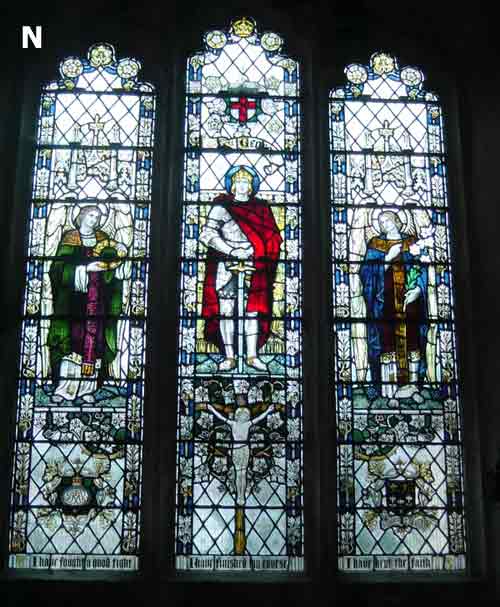
O.Plain Glass
P1. has the letter M, in a black versal cap. She stands on a carpet of green and white flowers. Around her head a scroll reads: Sancta Maria Mag in gold and black gothic caps and black gothic 1/c on white. The background to the scroll, and reaching to below the figure's shoulders, is red, below this it is brown as in (4). (7) (8) and (9) The architectural background is continued (as from (1) (2) and (3)) each containing a central angel with outspread gold wings and holding a scroll bearing words appropriate to the figure above, in black gothic caps and 1/c. (7) Angel standing on a green cloud, background red and brown, scroll: Thy will be done. (8) Angel on an orange cloud, background blue and brown, Scroll: I am the light of the world. (9)Angel on a green cloud, background red and brown, scroll: Lord remember me. There is a fillet across the foot of each light, of white alternating circles and diamonds on light brown, with a very narrow band of white above and below it. A BRASS PLAQUE is placed centrally on the sloping sill below the window (h.18cm x w.92cm). It has an incised black border line and bears the Streatfeild coat of arms to the left. BLAZON: Per fesse, Gu and Sa btw three bezants, two and one, surmounted by the family crest of a torque with an arm in armour ppr issuant bent from the elbow supporting a spear and pennon Gu Motto: Data fata sequutus The pennon and background to the upper two bezants are in red crackled enamel, the background to the lower bezant is black. There is some damage to the red enamel between the bezants on the pennon. The inscription in black gothic caps and 1/c: Sacred to the memory of Henry Dorrien Streatfeild of Chiddingstone,/Formerly Captain 1 Life Guards,/Born August 2 1825 Died March 27 1889/This window is erected in loving remembrance by his friends and the tenants and cottagers on the estate /
"Not as I will but as thou wilt"
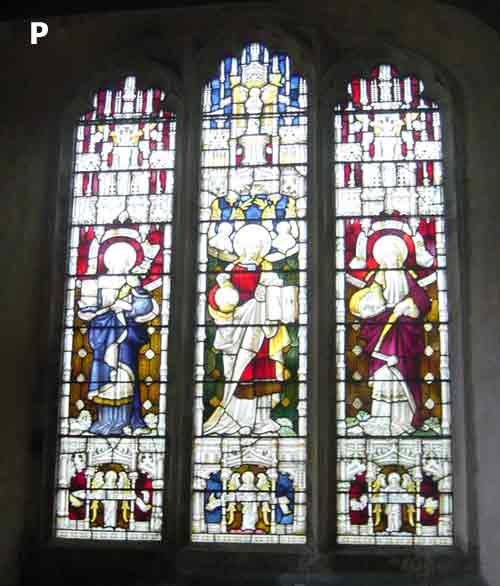
Q. WINDOW OF 3 LIGHTS and 7 TRACERY LIGHTS
Stonework: Square-headed 14th c window, much repaired with cement, is of light grey fine-grained sandy limestone, probably Kentish Rag from near Maidstone. Ref. a). Triple lancet, each with a pointed trefoil head. Tracery Lights: Quatrefoil or part, two complete and five in part after damage. Each has a clear fillet with inner beaded border, (2) (5) and (6) in red; (1) (3) (4) and (7) ultramarine, each enclosing a black and white foliated pattern with a diamond shape in the centre. In (1) (3) (5) and (6) the diamond is blue with a red central flower and gold alisee pat'ee cross within a small circle at each point. The flower of (5) and (6)
has a central green circle: (2) has a red diamond, blue flower and gold alis~e patee cross; (4) and (7) have a red diamond and green alisee pat'ee cross within a circle. Main Lights: (8) - (11) (8) and (9) Identical lights, pointed trefoil-headed filled with clear diamond quarries. (10) As above, except that at the base there is a rectangular opaque light (11) which bears an inscription in painted brown italic caps and 1/c with a plain fillet border having three small square blue inserts at top and bottom. A wavy lead bisects the light from top to bottom of the inscription (not the fillet).
Main lights post 1939-1945 war.Tracery lights may be earlier than 1862.
5-7. This 14th c window was rebuilt after the fire of 1624, and later
destroyed by bomb-blast during the 1939-1945 war. According to Osbourne
" it was no artistic loss, as it was probably one of the worst pieces of stained glass in Kent, colour being angry browns, crimson lake and vivid greens and the whole thing copied, it would seem, from a design in Berlin wool". It was then restored to its present form.
The original coloured window in memory/of Charlotte wife of Henry Streatfeild,/who died Oct. 10th 1852 aged 73 years and/ destroyed by blast during the war 1939-1945.
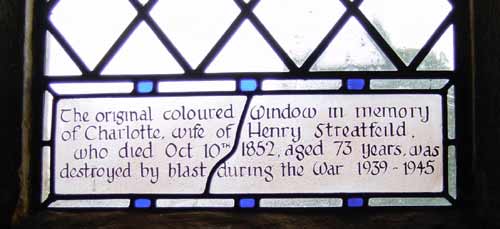
|
|
